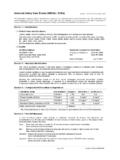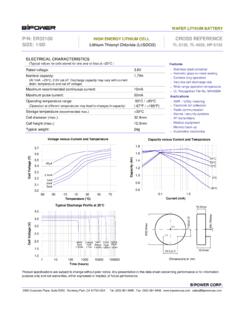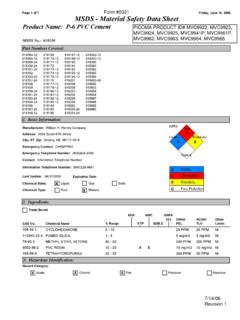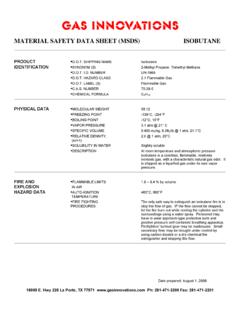Transcription of (Material) Safety Data Sheet (SDS / MSDS) - …
1 ( material ) Safety data Sheet (SDS / msds ) OSHA - HCS 29 CFR The information contained within is provided as a service to our customers and for their information only. The information and recommendations set forth herein are made in good faith and are believed to be accurate as of the date of preparation or revision. BiPOWER makes no warranty expressed or implied, and disclaims all liabilities from reliance on it. Section 1 Identification Product Name and Description: Battery: Lithium-ion, Rechargeable, Non-venting cells and batteries. Electro-chemistry: Lithium-ion (Li-ion). This Safety data Sheet covers all lithium ion rechargeable cells and batteries supplied by BIPOWER CORP. Supplier Office Address Telephone Numbers For Information BiPOWER CORP. Telephone: (323) 981-9498. 2560 Corporate Place, Suite D203 Fax: (323) 981-9468.
2 Monterey Park, CA 91754 Emergency Telephone: (323) 981-9498. USA Date of Revision: January-11-2017. Section 2 Hazard(s) Identification The lithium ion cell/battery covered in this data Sheet is hermetically sealed in an aluminum alloy or metal case and not hazardous if used as recommended by the manufacturer. Under a normal condition of use, the electrode materials and electrolyte contained in a cell/battery are non- reactive provided the battery integrity is maintained. Risk of exposure exists only in case of mechanical, electrical or thermal abuse. Warning: the cells/batteries should not be short circuited, punctured, incinerated, crushed, immersed in water, over-discharged, or exposed to a temperatures above the declared operation temperature range of the cell or battery. Risk of fire or explosion may occur in the above condition of abuse.
3 Section 3 Composition/Information on Ingredients Chemical Name CAS Number EINECS Number % by Weight Lithium Cobalt Oxide 12190-79-3 235-362-0 25 - 35. Carbon, various forms 7440-44-0 231-153-3 10 - 30. Polymer Binders NA NA - 1. Copper 7440-50-8 231-159-6 1 - 15. Aluminum 7429-90-5 231-072-3 1 - 10. Biphenyl 92-52-4 202-163-5 - Organic Carbonates NA NA 5 - 10. Lithium Salts NA NA 1-6. Section 4 - First-Aid Measures In case of battery rupture, major leakage or explosion, evacuate all workers and quarantine the contaminated area. Provide good ventilation to clear out any evacuate fumes, gases or the pungent odor. Eyes - Rinse eyes with plenty of water for 15 minutes; Seek immediate medical attention. Skin - Rinse affected area with plenty of water and soap or take a shower for 15 min;. Inhalation - Expose the person to fresh air and use artificial respiration if needed.
4 Seek medical attention if necessary. Ingestion - Consult a physician or local poison control center immediately;. Page 1 of 4. material Safety data Sheet OSHA - HCS 29 CFR Section 5 - Fire-Fighting Measures Extinguishing media: 1. Dry chemical or water type extinguishers are the most effective means to extinguish a cell or battery fire. 2. A carbon dioxide (CO2) extinguisher is also effective. Special fire fighting procedures: Respiratory protection: In all fire situations, wear self-contained breathing apparatus (SCBA) and chemical apron. Skin protection: Wear full fire fighting protective clothing and equipment to prevent body contact with electrolyte solution. Eye protection: Safety glasses are recommended. During water application, caution is advised as burning pieces of flammable particles may be ejected from the fire.
5 Causes of unusual fire or explosion hazard: Cells or batteries that are damaged, opened or exposed to excessive heat/fire may flame or leak potentially hazardous organic vapors. Section 6 - Accidental Release Measures Procedures to contain and clean up leaks and spills: Under a normal condition of use, a battery is hermetically sealed and not hazardous. Leakage or release of hazardous materials contained within a battery would be possible under abusive conditions. In the event of battery rapture and leakage: contain the spills and cover the spills or leakage with dry sand or 1:1 mixture of soda ash and slaked lime. Rubber gloves must be used to handle all battery components. Avoid inhalation of any vapors that may be emitted. Damaged batteries that are not hot or burning should be placed in a sealed plastic bag or container.
6 Section 7 - Handling and Storage Precautions for safe handling: Avoid any contact with the contents in case of rupture, leakage or explosion. Follow the procedures in Section 6 to handle and dispose the spills or waste. Batteries are designed to be recharged. However, improperly charging a cell or battery may cause the product to flame or leak. Use only approved chargers and procedures. Never disassemble a battery or bypass any Safety device. More than a momentary short circuit will cause temporary battery voltage loss until the battery is subjected to a charge. Extended short-circuiting creates high temperatures in the cell. High temperatures can cause burns in skin or cause the cell to flame. Avoid reversing battery polarity within the battery assembly. To do so may cause cell to flame or to leak. Conditions for safe storage and incompatibility: Batteries should be separated from other materials and stored in a non-combustible, well ventilated structure with sufficient clearance between walls and battery stacks.
7 Do not place batteries near heating equipment, nor expose to direct sunlight for long periods. Do not store batteries above 60 C (140 F) or below -20 C (-4 F). Store batteries in a cool (below 25 C (77 F)), dry area that is subject to little temperature change. Do not store batteries in a manner that allows terminals to short circuit. Maintain the state of charge level at 30-50% when the cell is placed in storage. Page 2 of 4. material Safety data Sheet OSHA - HCS 29 CFR Section 8 - Exposure Controls/Personal Protection Engineering controls and work practices: Under conditions of normal use, batteries do not emit hazardous or regulated substances. No engineering controls are required for handling batteries that have not been damaged. Personal protective equipment: Personal protective equipment should include chemical resistant gloves and Safety glasses.
8 In the event of a fire, SCBA should be worn along with thermally protective outer garments. Section 9 - Physical and Chemical Properties Appearance: prismatic or cylindrical, hermetically sealed metal container. Open Circuit Voltage (OCV): Charge temperature range: 0 C to +45 C. Discharge (operation) temperature range: -20 C to +60 C. Recommended storage temperature: 1 month: -20 C to +45 C; 6 months: -20 C to +35 C. Section 10 - Stability and Reactivity Stability: The batteries are stable under normal operation and storage conditions. Hazardous Polymerization: will not occur. Materials to avoid: water, strong acid or alkalis solutions, oxidizing agents. Conditions to avoid: short-circuiting, disassembling, over-discharging, heating over the declared operation temperature range of the product. Hazardous decomposition Carbon Monoxide (CO) and other VOC's products: Section 11 - Toxicological Information No toxicological impacts are expected under normal use conditions.
9 The electrolytes contained in this cell or battery can irritate eyes with any contact if released. Prolonged contact of electrolytes with lung tissue, skin or mucous membranes may cause irritation. Information regarding sensitization, carcinogenicity, mutagenicity or reproductive toxicity related to internal cell or battery components has not been included in this document. Section 12 - Ecological Information No ecological impacts expected under normal use conditions. Information on the ecological impact of internal cell or battery components has not been included in this document. Section 13 - Disposal Considerations Do not dispose in fire or submerge in water. Battery disposal regulations vary on national, state/provincial and local bases. Disposal must be conducted in accordance with the applicable laws and regulations.
10 These batteries contain recyclable materials and recycling is encouraged over disposal. Page 3 of 4. material Safety data Sheet OSHA - HCS 29 CFR Section 14 - Transport Information The regulations that govern the transport of rechargeable lithium ion (including polymer) cells and batteries include the International Civil Aviation Organization (ICAO) Technical Instructions and International Air Transportation Association (IATA) Dangerous Goods Regulations and International Maritime Dangerous Goods (IMDG) Code. The transportation of lithium ion cells and batteries of all types within, to and from the the United States are governed by US DOT CFR 49 Part 171-180 of the US Hazardous Materials Regulations (HMR). CFR 49 Part (c) and the Special Provisions contained in provide information on exceptions and packaging based on details of Watt-hour (Wh) rating, weight, tests and classifications.







